Hyundai Nexo 2019 Owner's Manual
Manufacturer: HYUNDAI, Model Year: 2019, Model line: Nexo, Model: Hyundai Nexo 2019Pages: 560, PDF Size: 24.2 MB
Page 511 of 560
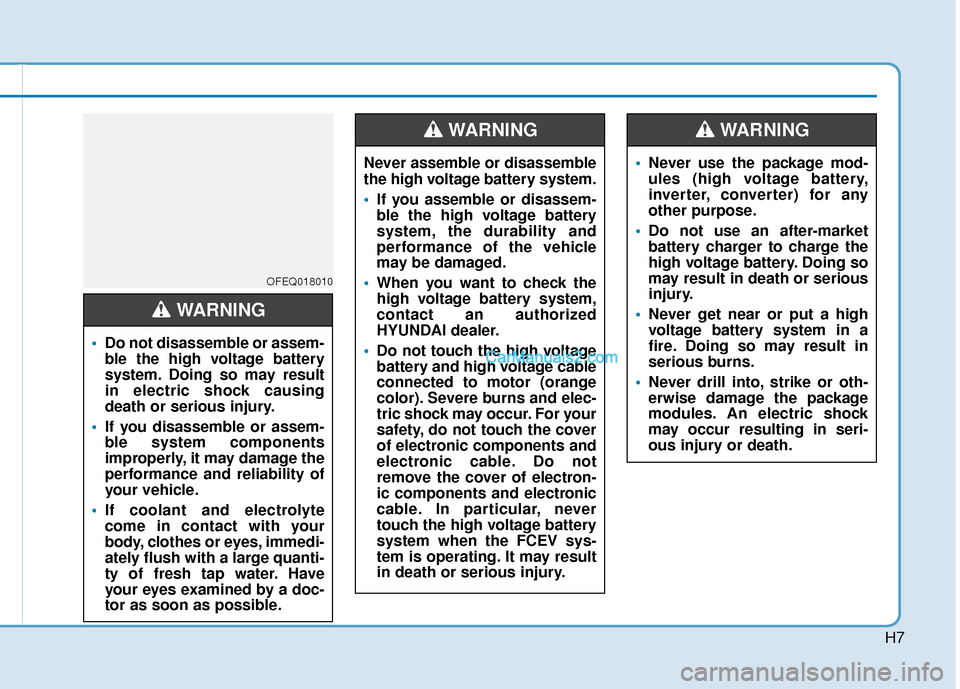
H7
OFEQ018010
•Do not disassemble or assem-
ble the high voltage battery
system. Doing so may result
in electric shock causing
death or serious injury.
If you disassemble or assem-
ble system components
improperly, it may damage the
performance and reliability of
your vehicle.
If coolant and electrolyte
come in contact with your
body, clothes or eyes, immedi-
ately flush with a large quanti-
ty of fresh tap water. Have
your eyes examined by a doc-
tor as soon as possible.
WARNING
Never assemble or disassemble
the high voltage battery system.
If you assemble or disassem-
ble the high voltage battery
system, the durability and
performance of the vehicle
may be damaged.
When you want to check the
high voltage battery system,
contact an authorized
HYUNDAI dealer.
Do not touch the high voltage
battery and high voltage cable
connected to motor (orange
color). Severe burns and elec-
tric shock may occur. For your
safety, do not touch the cover
of electronic components and
electronic cable. Do not
remove the cover of electron-
ic components and electronic
cable. In particular, never
touch the high voltage battery
system when the FCEV sys-
tem is operating. It may result
in death or serious injury.
WARNING
Never use the package mod-
ules (high voltage battery,
inverter, converter) for any
other purpose.
Do not use an after-market
battery charger to charge the
high voltage battery. Doing so
may result in death or serious
injury.
Never get near or put a high
voltage battery system in a
fire. Doing so may result in
serious burns.
Never drill into, strike or oth-
erwise damage the package
modules. An electric shock
may occur resulting in seri-
ous injury or death.
WARNING
Page 512 of 560
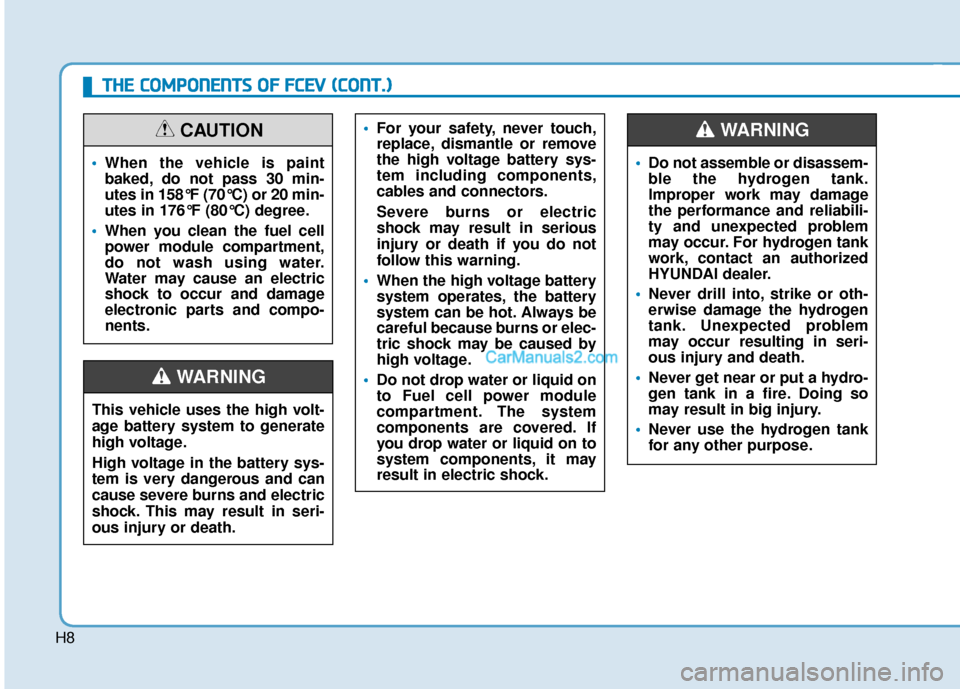
H8
T
TH
H E
E
C
C O
O M
M P
PO
O N
NE
EN
N T
TS
S
O
O F
F
F
F C
C E
E V
V
(
( C
C O
O N
NT
T.
.)
)
This vehicle uses the high volt-
age battery system to generate
high voltage.
High voltage in the battery sys-
tem is very dangerous and can
cause severe burns and electric
shock. This may result in seri-
ous injury or death.
For your safety, never touch,
replace, dismantle or remove
the high voltage battery sys-
tem including components,
cables and connectors.
Severe burns or electric
shock may result in serious
injury or death if you do not
follow this warning.
When the high voltage battery
system operates, the battery
system can be hot. Always be
careful because burns or elec-
tric shock may be caused by
high voltage.
Do not drop water or liquid on
to Fuel cell power module
compartment. The system
components are covered. If
you drop water or liquid on to
system components, it may
result in electric shock.
WARNING
When the vehicle is paint
baked, do not pass 30 min-
utes in 158°F (70°C) or 20 min-
utes in 176°F (80°C) degree.
When you clean the fuel cell
power module compartment,
do not wash using water.
Water may cause an electric
shock to occur and damage
electronic parts and compo-
nents.
CAUTION
Do not assemble or disassem-
ble the hydrogen tank.
Improper work may damage
the performance and reliabili-
ty and unexpected problem
may occur. For hydrogen tank
work, contact an authorized
HYUNDAI dealer.
Never drill into, strike or oth-
erwise damage the hydrogen
tank. Unexpected problem
may occur resulting in seri-
ous injury and death.
Never get near or put a hydro-
gen tank in a fire. Doing so
may result in big injury.
Never use the hydrogen tank
for any other purpose.
WARNING
Page 513 of 560
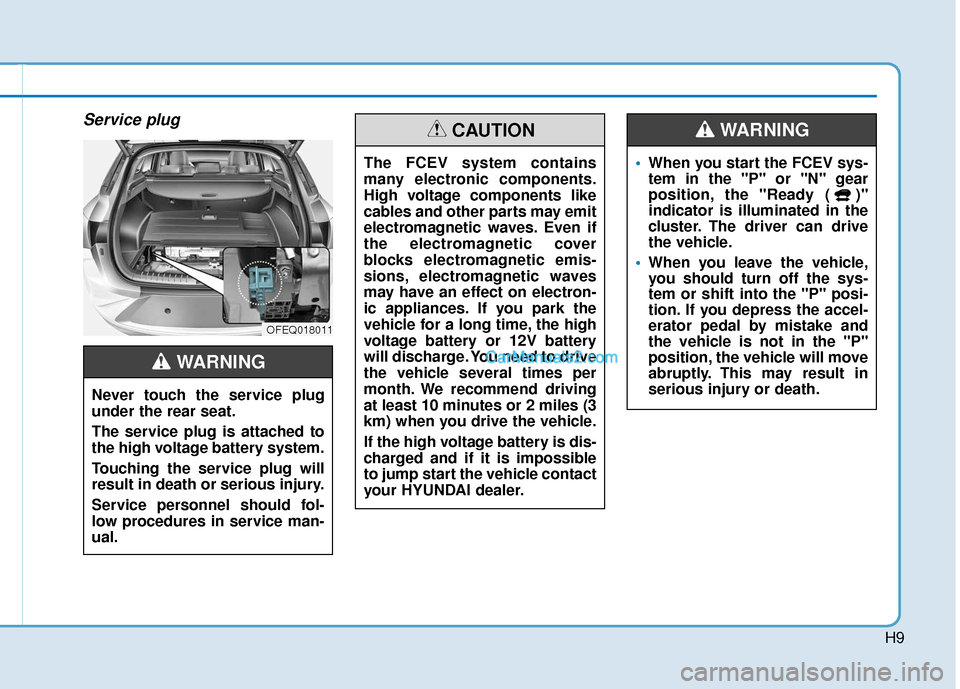
H9
Service plug
OFEQ018011
The FCEV system contains
many electronic components.
High voltage components like
cables and other parts may emit
electromagnetic waves. Even if
the electromagnetic cover
blocks electromagnetic emis-
sions, electromagnetic waves
may have an effect on electron-
ic appliances. If you park the
vehicle for a long time, the high
voltage battery or 12V battery
will discharge. You need to drive
the vehicle several times per
month. We recommend driving
at least 10 minutes or 2 miles (3
km) when you drive the vehicle.
If the high voltage battery is dis-
charged and if it is impossible
to jump start the vehicle contact
your HYUNDAI dealer.
CAUTION
When you start the FCEV sys-
tem in the "P" or "N" gear
position, the "Ready ( )"
indicator is illuminated in the
cluster. The driver can drive
the vehicle.
When you leave the vehicle,
you should turn off the sys-
tem or shift into the "P" posi-
tion. If you depress the accel-
erator pedal by mistake and
the vehicle is not in the "P"
position, the vehicle will move
abruptly. This may result in
serious injury or death.
WARNING
Never touch the service plug
under the rear seat.
The service plug is attached to
the high voltage battery system.
Touching the service plug will
result in death or serious injury.
Service personnel should fol-
low procedures in service man-
ual.
WARNING
Page 514 of 560
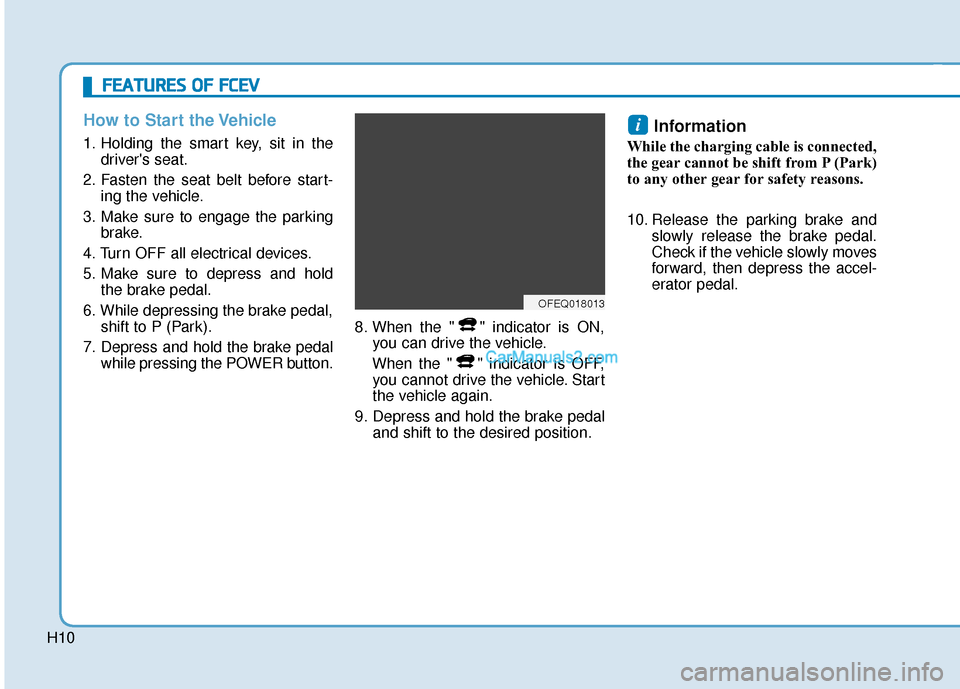
H10
How to Start the Vehicle
1. Holding the smart key, sit in thedriver's seat.
2. Fasten the seat belt before start- ing the vehicle.
3. Make sure to engage the parking brake.
4. Turn OFF all electrical devices.
5. Make sure to depress and hold the brake pedal.
6. While depressing the brake pedal, shift to P (Park).
7. Depress and hold the brake pedal while pressing the POWER button. 8. When the " " indicator is ON,
you can drive the vehicle.
When the " " indicator is OFF, you cannot drive the vehicle. Start
the vehicle again.
9. Depress and hold the brake pedal and shift to the desired position.
Information
While the charging cable is connected,
the gear cannot be shift from P (Park)
to any other gear for safety reasons.
10. Release the parking brake and slowly release the brake pedal.
Check if the vehicle slowly moves
forward, then depress the accel-
erator pedal.
i
F
FE
E A
A T
TU
U R
RE
ES
S
O
O F
F
F
F C
C E
E V
V
OFEQ018013
Page 515 of 560
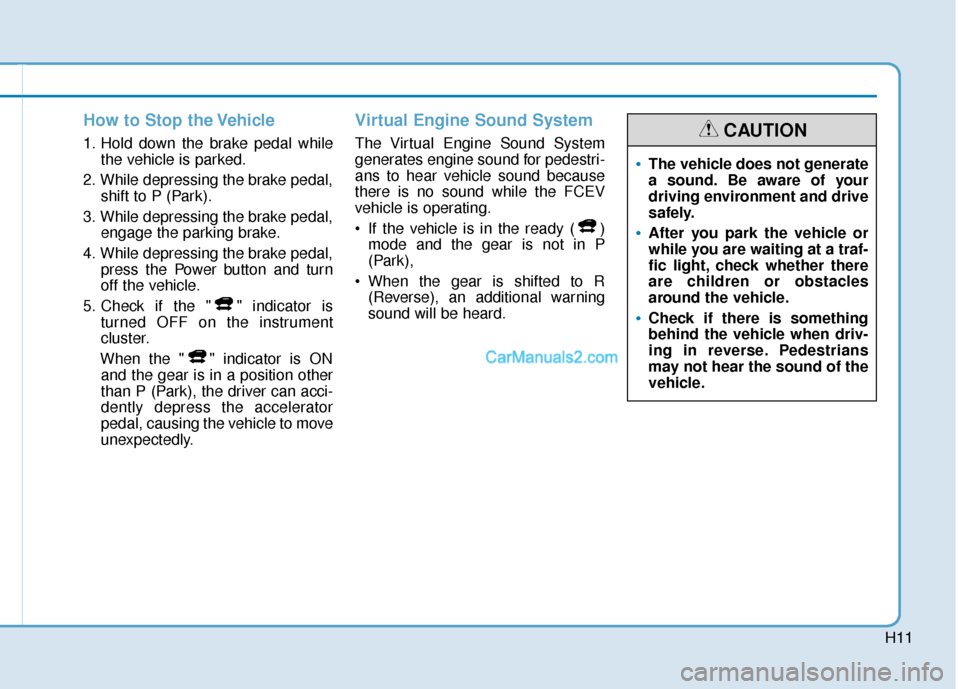
H11
How to Stop the Vehicle
1. Hold down the brake pedal whilethe vehicle is parked.
2. While depressing the brake pedal, shift to P (Park).
3. While depressing the brake pedal, engage the parking brake.
4. While depressing the brake pedal, press the Power button and turn
off the vehicle.
5. Check if the " " indicator is turned OFF on the instrument
cluster.
When the " " indicator is ON and the gear is in a position other
than P (Park), the driver can acci-
dently depress the accelerator
pedal, causing the vehicle to move
unexpectedly.
Virtual Engine Sound System
The Virtual Engine Sound System
generates engine sound for pedestri-
ans to hear vehicle sound because
there is no sound while the FCEV
vehicle is operating.
• If the vehicle is in the ready ( ) mode and the gear is not in P
(Park),
When the gear is shifted to R (Reverse), an additional warning
sound will be heard.
The vehicle does not generate
a sound. Be aware of your
driving environment and drive
safely.
After you park the vehicle or
while you are waiting at a traf-
fic light, check whether there
are children or obstacles
around the vehicle.
Check if there is something
behind the vehicle when driv-
ing in reverse. Pedestrians
may not hear the sound of the
vehicle.
CAUTION
Page 516 of 560
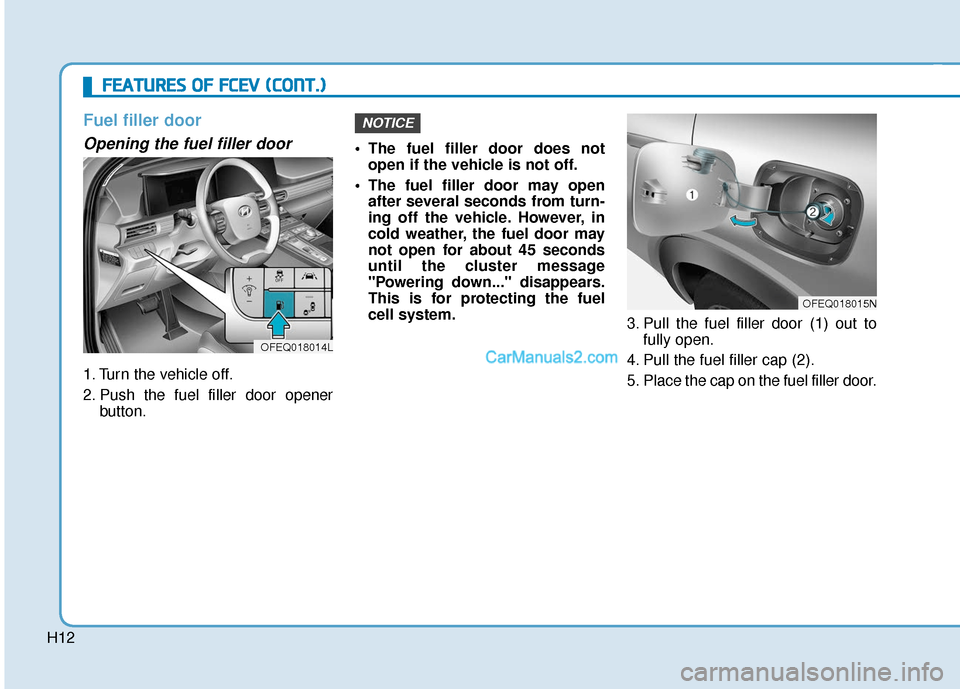
H12
Fuel filler door
Opening the fuel filler door
1. Turn the vehicle off.
2. Push the fuel filler door openerbutton. The fuel filler door does not
open if the vehicle is not off.
The fuel filler door may open after several seconds from turn-
ing off the vehicle. However, in
cold weather, the fuel door may
not open for about 45 seconds
until the cluster message
"Powering down..." disappears.
This is for protecting the fuel
cell system. 3. Pull the fuel filler door (1) out to
fully open.
4. Pull the fuel filler cap (2).
5. Place the cap on the fuel filler door.
NOTICE
F F E
E A
A T
TU
U R
RE
ES
S
O
O F
F
F
F C
C E
E V
V
(
( C
C O
O N
NT
T.
.)
)
OFEQ018014L
OFEQ018015N
Page 517 of 560
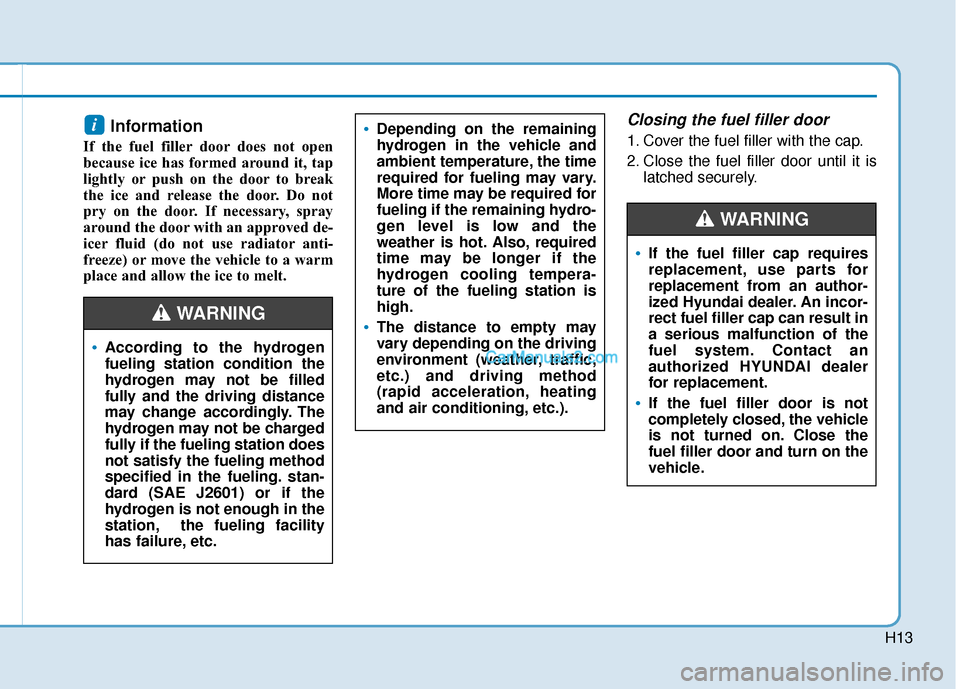
H13
Information
If the fuel filler door does not open
because ice has formed around it, tap
lightly or push on the door to break
the ice and release the door. Do not
pry on the door. If necessary, spray
around the door with an approved de-
icer fluid (do not use radiator anti-
freeze) or move the vehicle to a warm
place and allow the ice to melt.
Closing the fuel filler door
1. Cover the fuel filler with the cap.
2. Close the fuel filler door until it islatched securely.i
If the fuel filler cap requires
replacement, use parts for
replacement from an author-
ized Hyundai dealer. An incor-
rect fuel filler cap can result in
a serious malfunction of the
fuel system. Contact an
authorized HYUNDAI dealer
for replacement.
If the fuel filler door is not
completely closed, the vehicle
is not turned on. Close the
fuel filler door and turn on the
vehicle.
WARNING
According to the hydrogen
fueling station condition the
hydrogen may not be filled
fully and the driving distance
may change accordingly. The
hydrogen may not be charged
fully if the fueling station does
not satisfy the fueling method
specified in the fueling. stan-
dard (SAE J2601) or if the
hydrogen is not enough in the
station, the fueling facility
has failure, etc.
Depending on the remaining
hydrogen in the vehicle and
ambient temperature, the time
required for fueling may vary.
More time may be required for
fueling if the remaining hydro-
gen level is low and the
weather is hot. Also, required
time may be longer if the
hydrogen cooling tempera-
ture of the fueling station is
high.
The distance to empty may
vary depending on the driving
environment (weather, traffic,
etc.) and driving method
(rapid acceleration, heating
and air conditioning, etc.).WARNING
Page 518 of 560
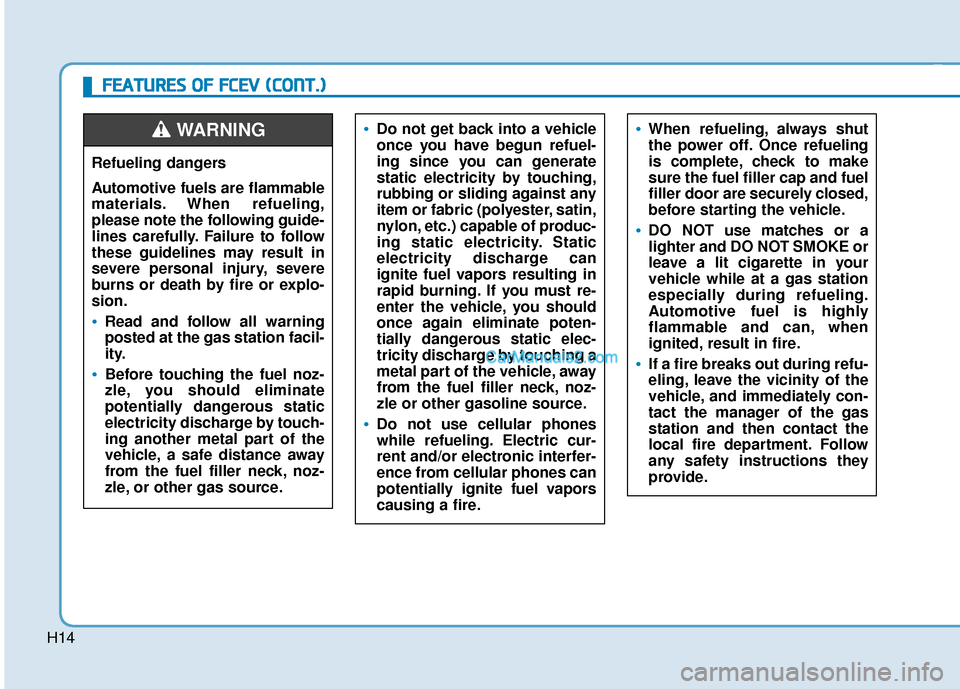
H14
Do not get back into a vehicle
once you have begun refuel-
ing since you can generate
static electricity by touching,
rubbing or sliding against any
item or fabric (polyester, satin,
nylon, etc.) capable of produc-
ing static electricity. Static
electricity discharge can
ignite fuel vapors resulting in
rapid burning. If you must re-
enter the vehicle, you should
once again eliminate poten-
tially dangerous static elec-
tricity discharge by touching a
metal part of the vehicle, away
from the fuel filler neck, noz-
zle or other gasoline source.
Do not use cellular phones
while refueling. Electric cur-
rent and/or electronic interfer-
ence from cellular phones can
potentially ignite fuel vapors
causing a fire.
When refueling, always shut
the power off. Once refueling
is complete, check to make
sure the fuel filler cap and fuel
filler door are securely closed,
before starting the vehicle.
DO NOT use matches or a
lighter and DO NOT SMOKE or
leave a lit cigarette in your
vehicle while at a gas station
especially during refueling.
Automotive fuel is highly
flammable and can, when
ignited, result in fire.
If a fire breaks out during refu-
eling, leave the vicinity of the
vehicle, and immediately con-
tact the manager of the gas
station and then contact the
local fire department. Follow
any safety instructions they
provide.
F FE
E A
A T
TU
U R
RE
ES
S
O
O F
F
F
F C
C E
E V
V
(
( C
C O
O N
NT
T.
.)
)
Refueling dangers
Automotive fuels are flammable
materials. When refueling,
please note the following guide-
lines carefully. Failure to follow
these guidelines may result in
severe personal injury, severe
burns or death by fire or explo-
sion.
Read and follow all warning
posted at the gas station facil-
ity.
Before touching the fuel noz-
zle, you should eliminate
potentially dangerous static
electricity discharge by touch-
ing another metal part of the
vehicle, a safe distance away
from the fuel filler neck, noz-
zle, or other gas source.
WARNING
Page 519 of 560
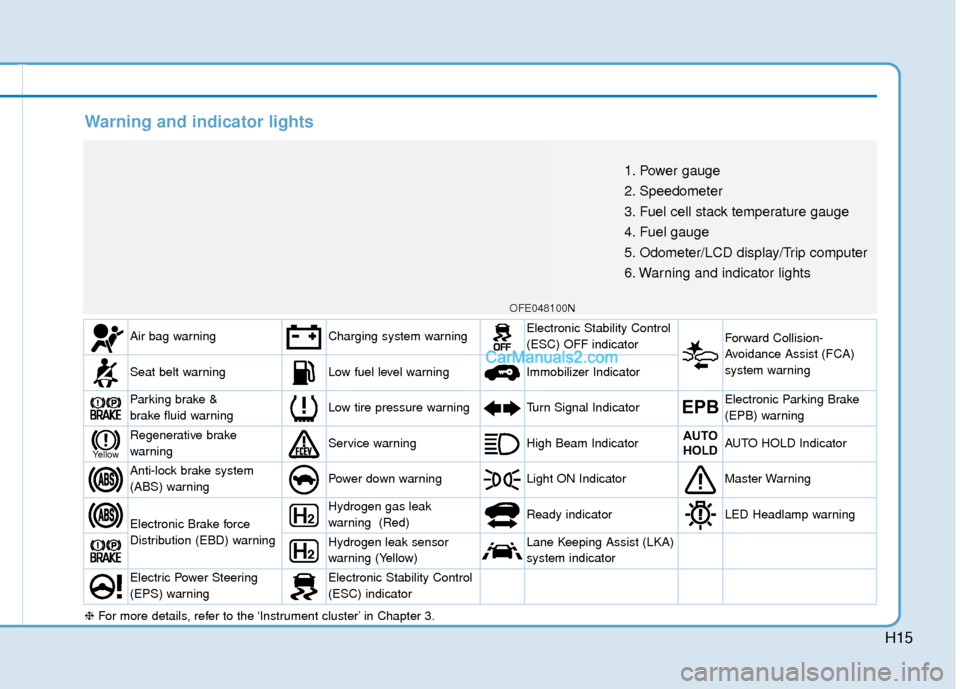
H15
Warning and indicator lights
OFE048100N
1. Power gauge
2. Speedometer
3. Fuel cell stack temperature gauge
4. Fuel gauge
5. Odometer/LCD display/Trip computer
6. Warning and indicator lights
Air bag warningCharging system warningElectronic Stability Control
(ESC) OFF indicator Forward Collision-
Avoidance Assist (FCA)
system warning
Seat belt warningLow fuel level warning Immobilizer Indicator
Parking brake &
brake fluid warningLow tire pressure warningTurn Signal IndicatorEPBElectronic Parking Brake
(EPB) warning
Regenerative brake
warningService warning High Beam IndicatorAUTO
HOLDAUTO HOLD Indicator
Anti-lock brake system
(ABS) warningPower down warning Light ON IndicatorMaster Warning
Electronic Brake force
Distribution (EBD) warning
Hydrogen gas leak
warning (Red) Ready indicatorLED Headlamp warning
Hydrogen leak sensor
warning (Yellow)Lane Keeping Assist (LKA)
system indicator
Electric Power Steering
(EPS) warningElectronic Stability Control
(ESC) indicator
Yellow
❈ For more details, refer to the ‘Instrument cluster’ in Chapter 3.
Page 520 of 560
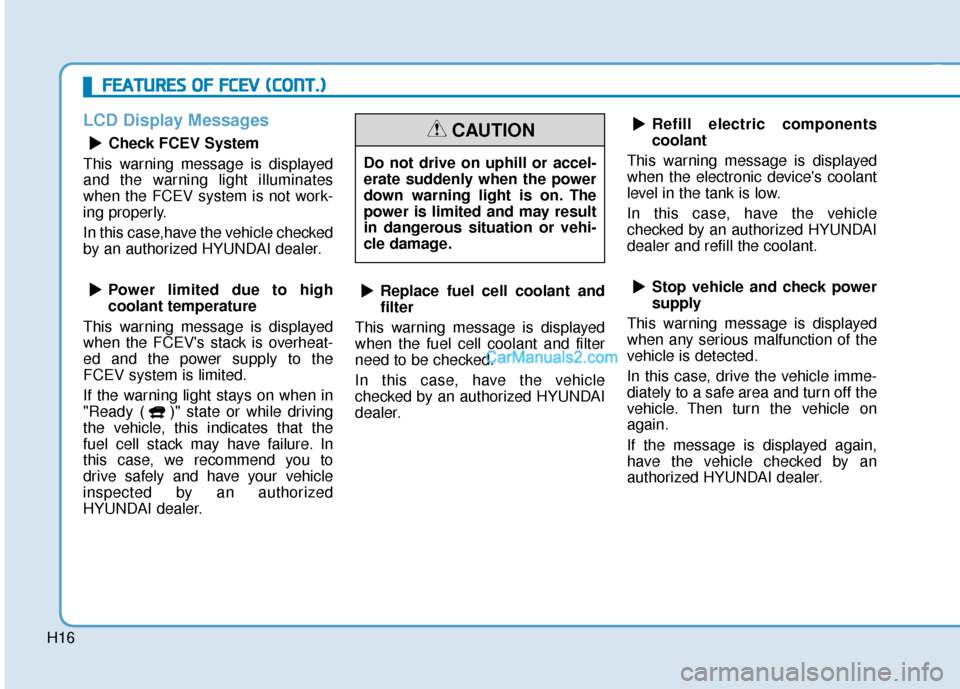
H16
F
FE
E A
A T
TU
U R
RE
ES
S
O
O F
F
F
F C
C E
E V
V
(
( C
C O
O N
NT
T.
.)
)
LCD Display Messages
Check FCEV System
This warning message is displayed
and the warning light illuminates
when the FCEV system is not work-
ing properly.
In this case,have the vehicle checked
by an authorized HYUNDAI dealer.
Power limited due to high
coolant temperature
This warning message is displayed
when the FCEV's stack is overheat-
ed and the power supply to the
FCEV system is limited.
If the warning light stays on when in
"Ready ( )" state or while driving
the vehicle, this indicates that the
fuel cell stack may have failure. In
this case, we recommend you to
drive safely and have your vehicle
inspected by an authorized
HYUNDAI dealer. Replace fuel cell coolant and
filter
This warning message is displayed
when the fuel cell coolant and filter
need to be checked.
In this case, have the vehicle
checked by an authorized HYUNDAI
dealer. Refill electric components
coolant
This warning message is displayed
when the electronic device's coolant
level in the tank is low.
In this case, have the vehicle
checked by an authorized HYUNDAI
dealer and refill the coolant.
Stop vehicle and check power
supply
This warning message is displayed
when any serious malfunction of the
vehicle is detected.
In this case, drive the vehicle imme-
diately to a safe area and turn off the
vehicle. Then turn the vehicle on
again.
If the message is displayed again,
have the vehicle checked by an
authorized HYUNDAI dealer.
▲ ▲
▲
▲
▲
▲▲
▲
▲
▲
Do not drive on uphill or accel-
erate suddenly when the power
down warning light is on. The
power is limited and may result
in dangerous situation or vehi-
cle damage.
CAUTION